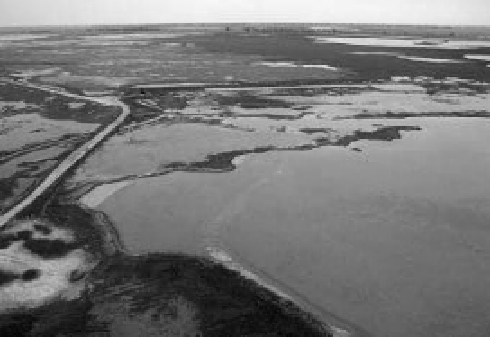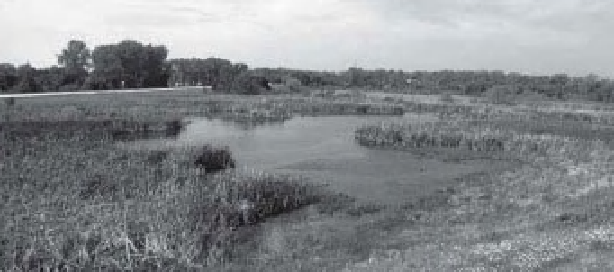Geoscience Reference
In-Depth Information
13.3 Wetland restoration, enhancement and
creation design principles
strategies that meet local needs yet preserve
vital wetland functions and processes necessi-
tates carefully crafted adaptive management
plans that ensure stakeholder input (Society for
Ecological Restoration International and IUCN
Commission on Ecosystem Management (SERI
IUCN) 2004).
Restoration projects that rel ect local geogra-
phies and meld into the broader landscape
stand the best chance of long-term success.
Based on the accumulated knowledge of wetland
restoration, enhancement and creation projects
from across the globe, an inventory of critical
principles and design elements emerge as key
to their long-term viability and success (Hammer
1997; Hay and Philippi 1999; Kent 2000a; U.S.
Environmental Protection Agency 2000; Zedler
2001; Mitsch and Jørgensen 2003; Quinty and
Rochefort 2003; Ramsar 2003; Society for Eco-
logical Restoration International 2004; SERI
IUCN 2004; Zedler and Kercher 2005; Mitsch
2006; Money et al. 2009; Ramseier et al. 2009;
van der Valk 2009; Natural Resources Conserva-
tion Service 2010c). These guiding principles,
synthesized from several studies, include the
following (Fig. 13-5):
Self-organizing and sustaining systems
-
The design of wetland restoration and creation
projects to mimic natural self-sustaining ecosys-
tems is key to their long-term success independ-
ent of human management. Ecosystems may be
thought of as l exible, self-organizing units that
adapt continually to their changing environ-
ments (Mitsch and Jørgensen 2003). Designing
Principles guiding the design and restoration of
wetlands incorporate ecological, economic and
social considerations to ensure self-sustaining
and resilient systems able to withstand natural
and human-induced stressors. Humans play
an integral role in the health of wetland ecosys-
tems and their participation is essential to
ensure productive outcomes. Design principles
acknowledge the vital role played by dependent
stakeholder communities and accommodate
their needs. Promoting sustainable resource-use
Figure 13-3.
Big Salt Marsh wetland complex at
Quivira National Wildlife Refuge in south-central
Kansas, United States. Saline ground water discharges
into springs and streams that feed into the marsh.
Water l ow is regulated through a series of canals,
levees, and control structures. View northeastward; kite
aerial photograph by S.W. Aber and J.S. Aber.
A
B
Figure 13-4.
Mitigation wetland at the intersection of two highways in eastern Kansas, United States. Cattails and
spike rush emerge among shallow pools (A) in a wetland that attracts a large variety of waterfowl and shorebirds,
including these Canada geese (B). Photos by J.S. Aber.








